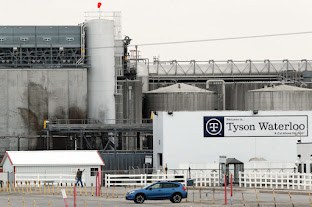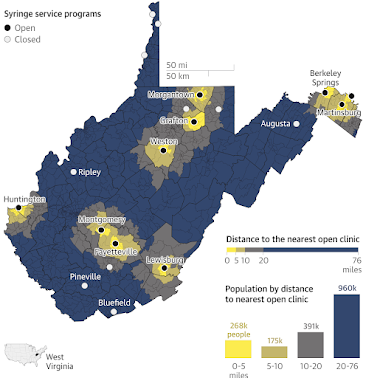 |
Average number of pain pills distributed per person, per year, by county, 2006-2014
(May by The Washington Post; click the image to enlarge it or click here for the interactive version.) |
Even as the opioid epidemic raged across the U.S. in 2013, the nation's top opioid manufacturer,
Mallinckrodt Pharmaceuticals, continued to aggressively court and lavishly reward doctors who prescribed more pain pills, even after sales reps cautioned the company that some doctors were running illegal pill mills, according to a treasure trove of newly released documents mined by Maryl Kornfield, Scott Higham and Steven Rich for
The Washington Post.
The company also "played a key role in an industry-wide effort to convince the health-care industry that addiction was rare among opioid users and marketed its drugs to specific segments of society" such as seniors, the Post reports. "The Mallinckrodt documents are part of a cache of 1.4 million records, emails, audio recordings, videotaped depositions and other materials the company turned over as part of its $1.7 billion bankruptcy settlement in 2020. Several state officials with claims against the company, led by Massachusetts Attorney General Maura Healey (D), urged that the documents be made public."
The Post was granted exclusive access to the files, which are part of the Opioid Industry Documents Archive, a digital vault of records created or obtained by state and federal opioid lawsuits and managed by Johns Hopkins University and the University of California at San Francisco; it's the largest repository of such evidence from an opioid company to date.
"For the first time in a long time, industry secrets are going to be turned over to the public and millions of documents will live online in an archive forever,” Healey told the Post. "Making this evidence available to the public will hopefully pave the way for important reforms that will stop dangerous conduct and save lives."
Though OxyContin maker
Purdue Pharma has been the prime bogeyman of the opioid epidemic, Mallinckrodt produced more narcotics because its pills were often more potent. "Between 2006 and 2014,
Mallinckrodt accounted for 27 percent of the opioid market compared with 18% for Purdue Pharma, measured by the potency of the pills they produced," the Post reports.
Mallinckrodt's 30-milligram Exalgo pill quickly became the opioid of choice on the street, and in Massachusetts supplied to more than half of the people who died from opioid overdoses in the past 12 years—far more than Purdue and its affiliate Rhodes Pharmaceuticals supplied, the Post reports.
Retired Drug Enforcement Administration supervisor Jim Geldhof, who investigated Mallinckrodt before his 2016 retirement and now consults with cities in opioid lawsuits, told the Post: "Everybody thinks of Purdue when they think about the opioid epidemic, but Mallinckrodt was far worse."
In videotaped depositions from 2018 to 2020, top Mallinckrodt executives "took little or no responsibility for the opioid epidemic. Several skirted questions about whether an opioid epidemic even existed," the Post reports. "For years, drug companies have argued they were simply filling orders written by medical professionals for legitimate patients. But the Mallinckrodt files show that the company had detailed knowledge of the prescribing patterns of doctors and bemoaned their loss when they fell into trouble with regulators." Sales representatives whose clients prescribed more Exalgo were showered with perks like free trips to Hawaii and Europe.
In six months in 2013, company sales representatives contacted the top 239 Exalgo prescribers more than 7,000 times. "More than a quarter of those prescribers — 65 — were later convicted of crimes related to their medical practices, had their medical licenses suspended or revoked, or paid state or federal fines after being accused of wrongdoing," The Post reports.
One of those top prescribers was Cincinnati orthopedic surgeon George Griffin, whom the company knew was in legal trouble for overprescribing pain pills. "For one patient, he prescribed 640 mg a day of OxyContin — despite warnings from a pharmacist that the patient was a drug dealer with a history of drug-related felonies, according to the board," the Post reports. In 2019 Griffin was convicted of unlawful distribution of controlled substances and sentenced to 40 months in prison.
A former Massachusetts doctor, Fathalla Mashali, who was convicted of health-care fraud and more, complained that the companies have not faced the same consequences as the doctors they influenced. "We got prosecuted criminally and we lost all our money, lost everything," Mashali said. "The Sacklers get to keep their money, Mallinckrodt to keep their money. All the companies get to keep their money."
As part of its 2020 bankruptcy settlement, Mallinckrodt turned over $1.725 billion to a trust serving communities affected by the opioid epidemic, the Post notes.


















